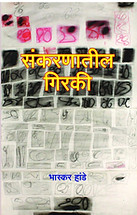











When one considers either, the structure of a painting, the colour or the subject matter, it is quite common to be disappointed with at least one of those factors within the painting. Of course ones brief differs from person to person and the importance of any one of the above considerations may also differ, and so it should.
When I first saw the paintings of Bhaskar Hande, I was impressed. I had found an artist, relatively unknown in Europe, whose paintings generally satisfied all of the aforementioned areas.
Firstly the question of structure is answered differently in each painting. There is not the stricture; of the 'golden section' with clinical regimentation, instead, with intuitive sensitivity, Bhaskar seems to find an equilibrium in his paintings that would satisfy most.
Again, the colours used in Bhaskar's painting give a satisfaction that I rarely experience. Having sat for prolonged periods in the 'Rothko Room' at the Tate Gallery I have absorbed the wonderful waves of subtle colour that emanate from the great mans paintings, my standards for such have been set very high. Although Bhaskar has an obvious respect for the physics of colour and the juxtaposition of one colour with another etc., he introduces a subtle nuance of colour within each painting that gives that extra magic.
Although I mention the 'subject matter' consideration lastly, I only do so because it is the cohesive component that brings everything together. Most of the paintings have titles that are very personal to the artist and only hint at the message. The rest is for you to interpretate after affording a little time to observe. Here also we have an artist that paints with words. His poetry is very important to him and conveys his attitude to the metaphysical world and one can easily see the natural evocation into his paintings.












 Bha-ka |  Bha-gha |  Bha-kha |
|---|---|---|
 Bha-ga |  Bha-cha |  Bha-bha |
 modify-01.jpg |  modify-02.jpg |  modify-04.jpg |
 Picasa - Dev_Da_2000_CGrafiek 01.jpg |  Picasa - Dev_Ta_2000_CGrafiek -4.jpg |  Picasa - Dev_Ma_2000_CGrafiek 03a.jpg |
 Picasa - Dev_TI_2000_CGrafiek 06.jpg |  Picasa - Dev_ka_2000_CGrafiek 02a.jpg |  Pting2005_03a.jpgDescribe your image here |
 Pting2005_04b.jpgDescribe your image here |  photo14a.jpgDescribe your image here |  pting2005_05.jpgDescribe your image here |
 photo04b.jpgDescribe your image here |  Pting2005_10a.jpgDescribe your image here |  paper painting 08 solarize dark 2011.jpgDescribe your image here |

The West has provided Bhaskar with a freedom to explore the possibilities in all kinds of materials. He considers that very freedom to select as a great challenge. He seems to cherish it and enjoy it.
Anyone who has been in India must be familiar with the sight of these dark green oval objects plastered up on large areas of walls, left out there to dry. Cow dung cakes, they are. Once dry, they are used as fuel for cooking. To convey this in painting, Bhaskar was looking for a material that would not only provide the texture but would project the heat and warmth that these cakes have absorbed from the sun. Typically, he took it as a challenge and found the answer in a piece of carpet.
Bhaskar Hande is also an avid collector of childrens' drawings and paintings. The child dares to portray the complex world around him or her through simple lines or through bold patches of colour. Bhaskar dreams of being able to plumb the depths of his alienated worlds with the same boldness and daring.
An exile does not really belong. His or her contributions are not readily claimed. Bhaskar Hande is aware of it. But he is not at all fazed by it. What is important to him is that he does not withhold his accent.
To quote Dilip Chitre again - 'During the last seven years, Hande has had one foot in India and the other in Europe. His dual mental life, his work as a painter and his self-reflection as a poet, must provide a different kind of energy as well as unique thematic substance'.




